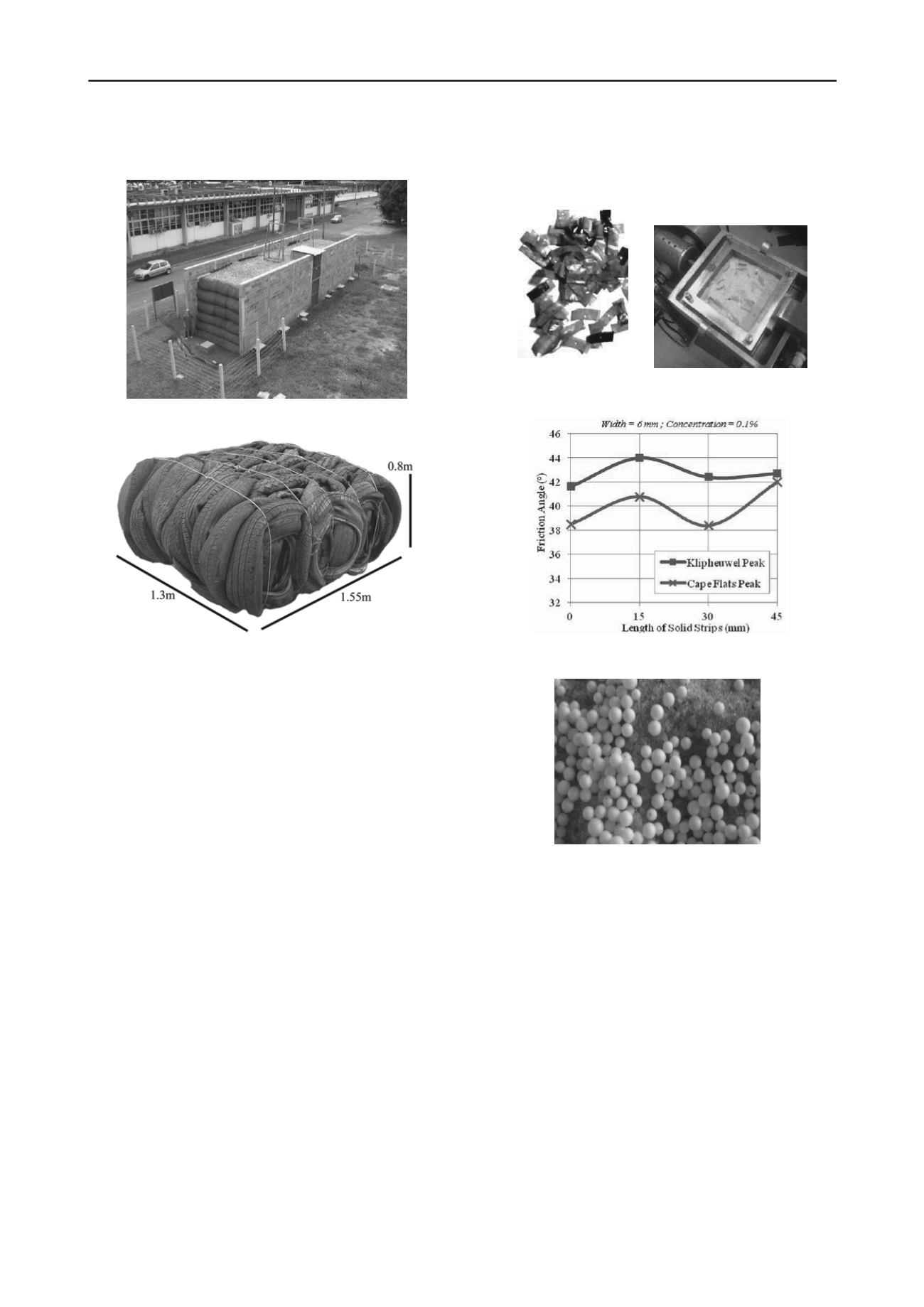
3158
Proceedings of the 18
th
International Conference on Soil Mechanics and Geotechnical Engineering, Paris 2013
and behavior associated with tire-bale use in construction,
example applications, and end-of-service-life options.
Figure 4. UnB retaining wall test facility (Figure 3 of Santos et al.).
Figure 5. A typical tyre bale (Figure 1 of Winter).
Abdelhaleem et al. considered the use of recycled rubber and
rubber-sand mixtures (RSM) as replacement soils in seismic
areas due to the increased damping capacity of RSM. They
performed site response analysis using the two-dimensional
finite element method with equivalent-linear constitutive
models for the geo-materials. Three earthquake ground motions
of comparable magnitude and varying frequency content were
applied to a deposit of sand with replacement soil and with
different configurations of RSM. A parametric study was
performed for investigating the effect of depth and thickness of
the RSM layer and of the relative magnitudes of the natural
period of the site and predominant period of earthquake on the
sand-replacement soil-RSM system.
Kalumba and Chebet investigated the possibility of using
discarded polyethylene shopping bags as soil reinforcement, and
performed direct shear tests on Klipheuwel and Cape Flats
sands mixed with perforated and non-perforated polyethylene
strips of different lengths and of widths (Figure 6). Direct shear
tests were performed with sand-polyethylene mixture and it was
observed that there was an overall increase in the friction angle
due to addition of the strips and that the increase in the friction
angle depends on the length and width of the strips, perforations
present in the strip, and percent weight of the strips (see, for
example, Figure 7). Based on their results, Kalumba and Chebet
suggested that the polyethylene strips can be used to increase
the shear resistance of sandy soils.
Abdelrehman et al. performed a laboratory-scale study to
investigate the efficacy of expanded polystyrene (EPS), a
cellular polymeric material commonly used in the packaging
industry, in reducing the heave in footings placed on expansive
clay (Figure 8). They studied the compaction characteristics of
EPS of different size and bead density mixed with silica sand.
Subsequently, Abdelrehman et al. studied the response of
circular footings of different diameters resting on a layer of
sodium bentonite by replacing a part of the bentonite layer with
the EPS-sand mixture. They performed a parametric study of
the footing heave-settlement response as a function of different
proportions of EPS-sand mixture, different replacement soil-
layer thickness, footing size, and bead density. Abdelrehman et
al. found that the swelling deformation of the footing decreases
as the replacement-layer thickness increases.
Figure 6. Direct shear tests with
polyethylene chips from shopping bags (adapted from Figures 1b and 2b
of Kalumba and Chebet).
Figure 7. Friction angle of sand mixed with non-perforated polyethylene
strips versus strip length (Figure 3a of Kalumba and Chebet).
Figure 8. Expanded polystyrene (EPS) beads mixed with sand (Figure 1
of Abdelrehman et al.).
In another example of EPS recycling, Teymur et al.
compared the performance of glass foam and EPS geo-foam as
components of controlled low strength material (CLSM) often
used as compacted backfill. They performed index tests,
unconfined compression tests, and CBR tests, and found that
glass mixtures have greater unit weight and strength than those
of EPS foam mixtures. They concluded that glass foam CLSM
can be used as pavement subbase, as fill for slopes and retaining
structures, and to increase the strength and stiffness of soft clay
deposits.
Drinking water sludge (DWS) discharged during water
purification has potential use as a road infrastructure material
(Watanabe and Komini). However, decomposition of the
organic matter present in DWS decreases its shear strength
because of which it is important to determine its durability for
reuse. Watanabe and Komini collected DWS samples from
Irabaki, Japan that contains aluminum and organic matters in
the solid phase, and performed triaxial tests on the samples after
subjecting them to aluminum leaching and biodegradation.
They found that the shear strength of DWS decreases due to loss
of organic matter and aluminum (Figure 9). Watanabe and
Komini further quantified the effect of aluminum leaching and


